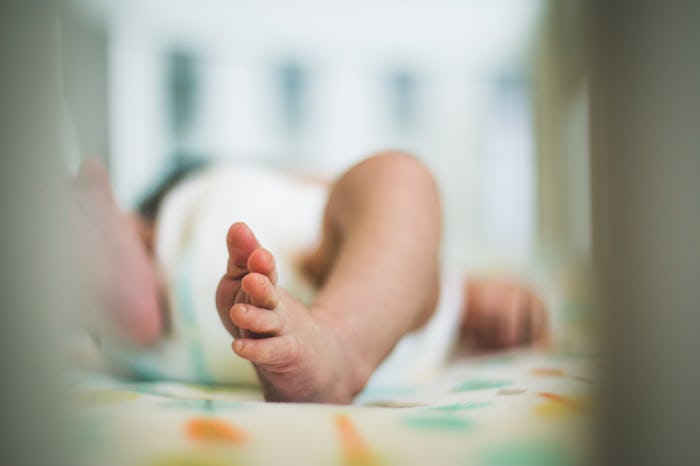News
New Research Highlights The Dangers Of Placing Babies To Sleep With Soft Bedding
The American Academy of Pediatrics (AAP) published a study on Monday that identified a leading cause of Sudden Infant Death Syndrome (SIDS). Using research from the U.S. Centers for Disease Control and Prevention (CDC), the authors of the investigation found that soft bedding puts babies at risk as it's the leading cause of injury death among infants under 1 year old in the United States. As such, experts are urging parents and caregivers to practice safe sleep recommendations.
In 2017, the CDC states that 26 percent of infant deaths were caused by accidental suffocation and strangulation in bed. Even more concerning is that infant death from accidental suffocation and strangulation has been on the rise since 1997, the CDC has found. In light of these troubling numbers, researchers — including experts from the CDC — conducted a study to find out why suffocation is a leading cause of death for infants.
Researchers analyzed national registry data from "1,812 cases of sudden unexpected infant death (SUID) between 2011 and 2014," according to Reuters. The research found that in one-third of the cases, 14 percent of the 1,812 deaths "involved suffocation," according to KFGO News. The AAP stated that the infant deaths had a "median age" of 3 months old and "the majority were male."
What's especially concerning is the relationship is between soft bedding and suffocation-related deaths. The study's authors concluded that 69 percent of the suffocation cases involved "soft bedding like a blanket or pillow," according to the AAP, and in these cases, blankets were the most common cause of suffocation, followed by "adult mattresses and pillows."
Additionally, the research found that most of the babies were lying on their stomach or side when the deaths occurred. This is an important detail as the AAP says infants should sleep on their backs on a firm surface with a tight-fitting sheet.
Lead study author, Alexa Erck, elaborated on the findings in an interview with Reuters. "Among soft bedding deaths, more than half of infants five to 11 months old had their airways obstructed by blankets compared with less than one-third of younger infants," she explained.
Erck also pointed out to Reuters why older infants are more likely to die from suffocation, explaining, “It is likely that these older, more developed infants were mobile enough to become entangled in blankets but were not yet coordinated enough to free themselves."
In cases where the parent shared a sleeping surface with a baby (overlay), the median age of death was "slightly lower at 2 months," and "neck or chest compression was more common than obstruction of the nose and mouth," according to TODAY.
As for wedging (when an infant gets trapped between two objects) cases, this "typically occurred in older infants with a median age of 6 months, and 73 percent occurred in an adult bed," according to Pediatrics.
In light of these findings, it's best for parents to put their infants to sleep on their backs in a sleeping space without soft bedding. "Keep soft bedding such as blankets, pillows, bumper pads, and soft toys out of their baby’s sleep area, and room share but not bed share with babies," the CDC recommends.
A safe sleep setting, as the AAP's website highlights, includes the following:
- A firm sleep surface such as a crib or bassinet with a tight-fitting sheet.
- A bare sleeping space, without soft bedding (think blankets, toys, pillows, etc.).
- A separate sleeping surface from parents, at least for the first six months.
- No exposure to smoke, alcohol, or drugs.
"Safe sleep environments can reduce infant suffocation deaths," the study's authors concluded. "Increased knowledge about the characteristics of suffocation deaths can help inform prevention strategies by targeting highest-risk groups."
Indeed, as this study has outlined, prevention and awareness are key in avoiding suffocation-related infant deaths. If you have any concerns about the CDC's new research, don't hesitate to reach out to a trusted medical professional to learn more about best sleep practices.
